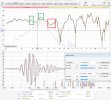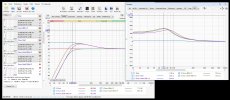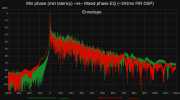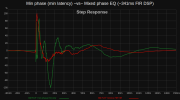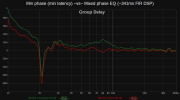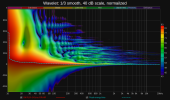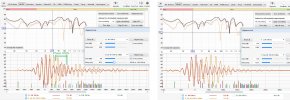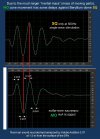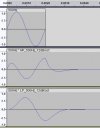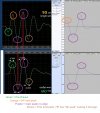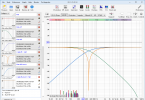Well, thank you for your kind and intensive insights for my post
#504 on the project thread.
First of all, I am sorry for giving you a little bit of confusion of air sound start direction,
kick-down-first or
kick-up-first, since you look at post
#504 before looking at post
#493. In all of the posts
#493,
#495, #497, #498,
#503,
#507, I always use the
kick-down-first sine-wave signals for excitation of SP drivers.
You would please understand the specific diagram of your interest in
#504 can be seen/observed in this way;
As you can clearly see, the
kick-down started at
3.340 sec time point in SQ room air sound, and in WO room air sound. Consequently, my placement of vertical guidelines and the reading of the
relative delay of WO sound's bottoms and peaks are correctly shown in the above diagram.
And, please be careful enough that the
horizontal (X-axis) scale is the actual real world clock-timing, and therefore
the X-axis should be precisely synchronized using the red vertical marker line at 3.340 sec and the green vertical marker line at 3.352 sec. We need to "observe and discuss" within the
precisely synchronized 0.012 sec (12 msec!) time window in this specific case.
(In this specific case, I time-shifted the "whole" of the recorded sound including/using the 10 kHz time zero marker monitored by tweeter so that the kick-down time point is seen at arbitrary 3.340 sec. Of course I precisely confirmed that the kick-down start timing was exactly identical, i.e. identical absolute time distance from the time-zero marker, for both of SQ sound and WO sound in the intact recorded air sound data.)
This clearly tells, therefore, that your suggested WO inverted diagram/simulation (in staggered X-scale) is not correct, is not reflecting the real world time sequence.
Also please note that I always have 10 kHz very "sharp" time-zero marker which can be "heard/recorded" by tweeter (or super-tweeter) for exact precise time-scale synchronization for all the independently recorded real world sounds. You can easily understand this "mechanism" by reading my post #493.
Now I know your intensive insights on the reasons for two-wave aftershock in SQ sound. At present, I myself do not fully know/determine such aftershock would be due to "
simple physical inertia aftershock" or
"wave packet" (which you are speculating first) or
"-12dB/Oct LR filters I use" or
"some room reflection", or any others.
As for the two-wave aftershock in SQ sound, I found your speculations would be interesting and highly possible for which I greatly appreciate.
I believe "some room reflection" can be excluded from the reason(s) judging from the clean shape and time-sequence of the aftershock pattern, and the
"simple physical inertia aftershock" would be highly possible for WO sound. (Furthermore, the identical
only one-wave aftershock with WO was clearly seen by 8-wave excitation; please refer to my post
#493.)
And we can see, even by 500 Hz stimulation, second and third aftershocks in WO sound are well suppressed into almost negligible level thanks to the rigid-heavy sealed well damped SP cabinet and the directly-driving (no passive LCR-network) excellent amplifier YAMAHA A-S3000 having nice damping power.
In any way, the most important observation here, however, is that
"we are looking at the real world air sound wave shapes and their timings", whatever would be the patterns and reasons for the aftershocks, whatever (how much) would be the relative delay of the air sound waves, and whichever would be the main bottom(s) and main peak(s).
And you would be please reminded that the
ultimate purpose of "this measurement" is to quantitatively assess the relative delay of WO sound against SQ sound giving the useful and important clue for further intensive objective "time alignment tuning" which described in detail in the rest of my post
#504.
And, as you may fully agree,
we can easily "validate" the accuracy and reproducibility of this measurement approach by giving intentionally larger group delay in upstream DSP.
EDIT:
One of other excellent pros of this measurement approach is that we can easily "retrospectively" analyze all the "recorded" intact data having the time-zero marker anytime after the date of the measurement. Of course I have been keeping all the test tone signals and all of the intact recorded room air sound tracks in my PC-SSD for possible present (just like I looked the data again yesterday-today) and future re-analysis and re-evaluations.
